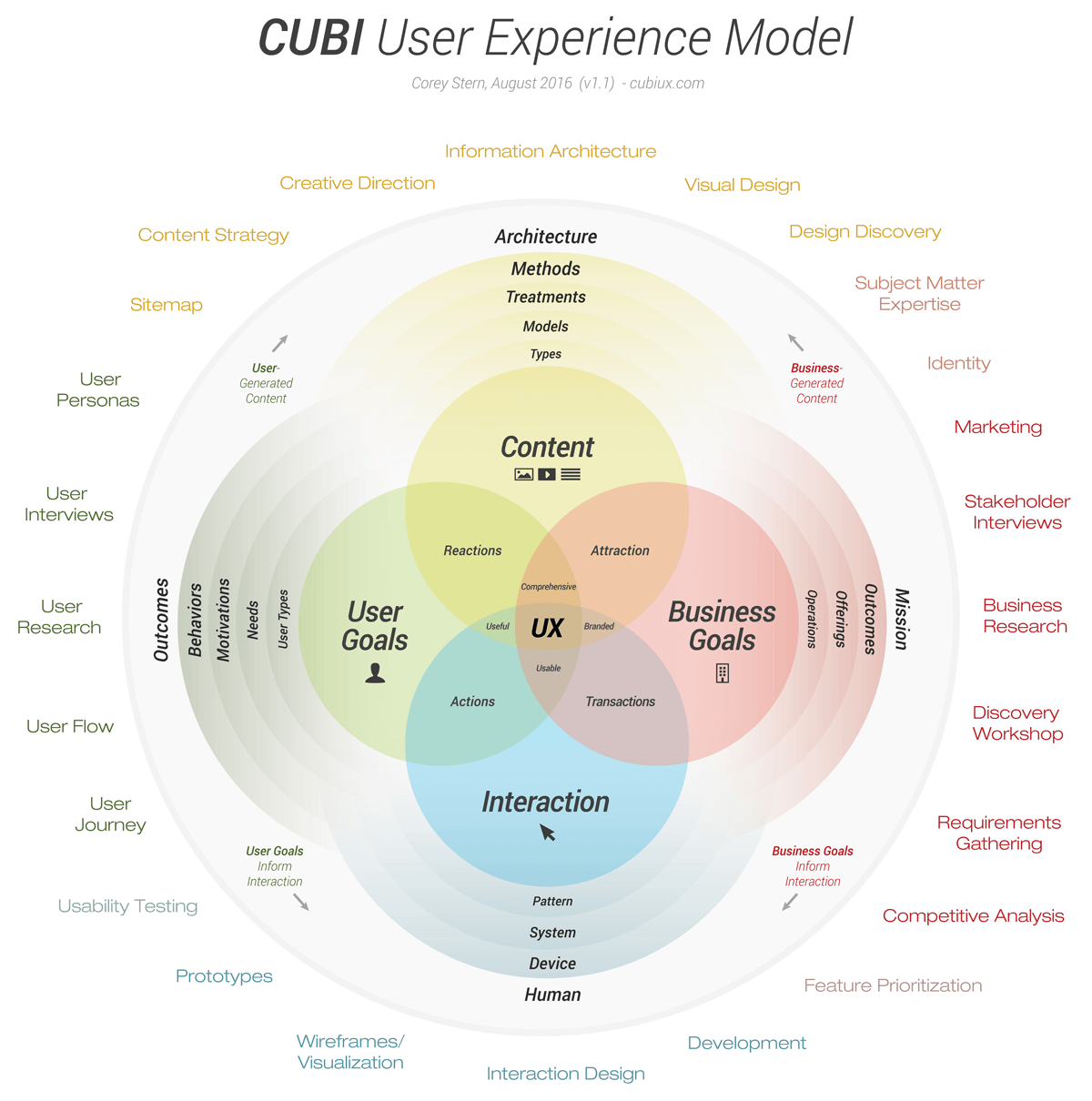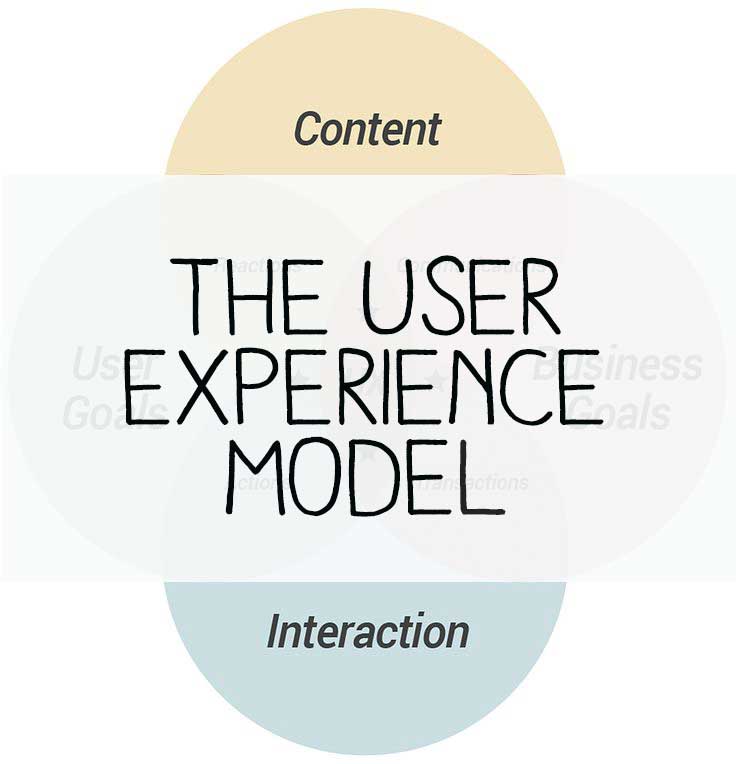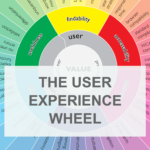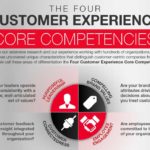The User Experience Model CUBI.
User Experience Model
The important part of any UX design project is to solve business problems and engage users through meaningful and valuable experiences. With tight budgets and limited timelines it’s often difficult to develop innovative UX designs. That is when a good user experience model comes in use.
One of the problems of UX is the whilst many diagrams present the disciplines, stages, tools and methods few were simple. Even fewer focused on the business value. Most UX diagrams are confusing, unorganised, complex, or antiquated.
Henry Ford once said …
“I invented nothing new. I simply assembled the discoveries of other men behind whom were centuries of work… Progress happens when all the factors that make for it are ready and then it is inevitable.”
Henry Ford
When considering designing user experiences it’s important to identify how each element overlaps with user goals and business goals. The simple CUBI User Experience Model helps by illustrating the major components. These consist of:
- Content
- User Goals
- Business Goals
- Interaction
The Benefits of a Simple Experience Model
The user experience model needs to address a number of different contexts and perspectives:
- Creativity: Creative experiences is vital to engage users and deliver unique brand experiences. The model provides a framework for presenting content more creatively, through use of a variety of techniques and methodologies.
- Communication: Creating and clarifying language between designers and clients provides for greater communication and improves the strategy and ultimately the results.
- Simplification: This model simplifies the complex design process into bite-sized pieces. It outlines the many considerations needed.
- Collaboration: This user experience model is good for designing experiences because it can be used to clarify roles, teams, assets, and content required to execute.
- Gaps: The user experience model can help identify gaps within the design process.
#1. The User Experience Model – Content
There are five layers to consider when incorporating content—Content Types, Models, Treatments, Methods, and Architecture.
- Content Types: Content is more than just text. Content includes media: photography, video, audio, data (visualisations), documents, and many other forms. When content types are combined there are more opportunities for creative forms of communication and engagement. It’s important to develop and inventory of the different media of content and the context of how else and where it will be used.
- Content Models: Content models combine different content types into a more recognisable model or format. For example, a recipe is a content model, which may include content types such as ingredients, instructions, and photography.
- Content Treatments: Content can also have applied aesthetics and treatments. Content needs to align with the brand and convey the brand clearly.
- Content Methods: Content can be presented in creative ways. It can be vastly more interesting and engaging when used to create stories including metaphors, analogy, symbolism, scenarios, challenges, or other creative concepts.
- Content Architecture: Content architecture is the structure and organisation of information in a website or software system or even in a retail store. It touches all content categories including content types and models.
To summarise, Content Types are aggregated to create Content Models. The content types and models have applied Content Treatment. A Content Method can provide a narrative or framework for the content. All of these elements are organised through Content Architecture.
#2. The User Experience Model – User Goals
There are five layers to consider when incorporating user goals: User Types, Needs, Motivations, Behaviors, and Outcomes.
- User Types: It’s important to understand the different types of users. A good practice is to create personas. A persona details different roles, responsibilities, skill-levels, demographics (gender, age range, languages, locations, etc.) and psychographics (personality, values, attitudes, interests, lifestyles). Using personas different needs can be identified on where, when and how each will use the product.
- Needs: Once user types are identified, it is critical to understand and define the relevant needs and aspirations that will help fulfil their goals. Some needs may be more simple, like finding documentation, while others are more complex more physiological or esteem needs.
- Motivations: Once the user needs are identified, it’s important to understand the motivations. This could be a wide range of intrinsic or extrinsic rewards or motivators, implemented with cues, design triggers, or other techniques.
- Behavior’s: After the motivations are identified, user research can identify potential changes. With enough motivation and behaviour change, there is a greater likelihood of developing new habits and loyalty to a product and brand.
- Outcomes: The combination of Needs, Motivations, and Behaviors can then lead to meaningful and measurable outcomes for users.
#3. The User Experience Model – Business Goals
There are four layers to consider when incorporating business goals—Operations, Offerings, Outcomes, and Mission.
- Operations: Each project has operations that support the product, which can include people, resources, and other connected experiences. People involved in the project can be key business stakeholders, content contributors, subject matter experts, collaborators, administrators, recruited users and others involved in the project. Connected Experiences can happen prior, during and after the experience. It is vital to understand how the product will be found by users. Clearly internal communications or external marketing such as advertising. Other methods might include App Stores, search engines or through social media. This helps make communications consistent, congruent, professional and focused. Then users may interact with departments like customer support, technical support, human resources, or others.
- Offerings: The business may offer an ecosystem of products and/or services. It’s also important to understand how these products and services relate to each other. To communicate these offerings, the business need a clear value proposition.
- Outcomes: The offerings ultimately support meaningful metrics and Key Performance Indicators that help support business success. KPIs may include financial performance, customer acquisition goals, increased customer satisfaction, employee performance metrics, call center metrics, or other indicators.
- Mission: A mission statement provides the core purpose of an organisation, its competitive advantages, its target audience, and the reason the organisation exists. The mission statement should guide decisions and clearly define goals.
#4. The User Experience Model – Interaction
There are four layers to consider when incorporating interaction—Patterns, Systems, Devices, and Humans.
- Pattern Interaction: Design patterns (AKA Micro Interactions) are reusable components and interactions. Patterns include everything from headers and menus to calendars and maps. Resource libraries for patterns include Pattern Tap, Mobile Patterns…
- System Interaction: The system can contain navigation, flows, feedback, and notifications to help the user progress and achieve their goals. The nature of the system can either be static, meaning that it is unchanged or dynamic meaning there is constant change or activity within the system. Dynamic systems can be regulated or self-regulated, meaning there are varying degrees of permissions and actions certain users perform based on their credentials. Systems can also be defined by the content management system or other system software, which may have a set of capabilities and as well as limitations.
- Device Interaction: When designing for an experience it’s key to understand the capabilities and constraints of the targeted devices, including screen sizes, connectivity, user interface conventions and other factors. The experience could happen with a variety of devices including phones, tablets, kiosks, terminals, watches, appliances or other things. For example, modern phones can support gestures, geolocation, accelerometers, audio recording, camera capabilities, push notifications and other features that are native to modern phones. User interface design considerations are also made to provide experiences that are ergonomic and comfortable when using certain devices.
- Human Interaction: The human interaction may be formal or informal, personal or interpersonal, social, or some other type of human interaction.
User Experience Model Infographic



